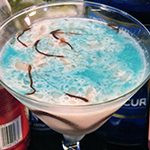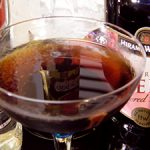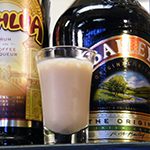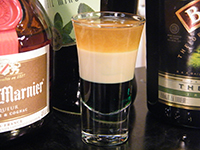 St. Patrick’s Day is both a day to get debauched to the best of your ability and a day of great Irish national pride. Never mind that people who aren’t even remotely close to being Irish still find a reason to drink like it’s their last ever chance to party. But what to order at the bar, or put together at home if you don’t feel like Guinness? Here’s the perfect solution, in the form of Irish Flag Shots. This tri-color shooter will have you feeling as Irish as they come within a few rounds.
St. Patrick’s Day is both a day to get debauched to the best of your ability and a day of great Irish national pride. Never mind that people who aren’t even remotely close to being Irish still find a reason to drink like it’s their last ever chance to party. But what to order at the bar, or put together at home if you don’t feel like Guinness? Here’s the perfect solution, in the form of Irish Flag Shots. This tri-color shooter will have you feeling as Irish as they come within a few rounds.
Irish Flag Shots
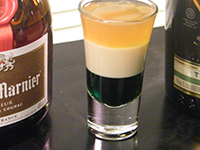
- 1 part crème de menthe
- 1 part Baileys Irish cream
- 1 part Grand Marnier
In a tall shooter glass, pour the crème de menthe in the bottom third. Next, layer the Baileys by pouring it on the back of a bar spoon, to about two-thirds full. Lastly, layer the Grand Marnier on top. Don’t be discouraged if this takes a couple of attempts to master. Angling the spoon to touch right above the previous layer seems to help. Also, this won’t work if you reverse the order of the layers (as I did while filming the video before finally figuring it out. D’oh!)
Take a moment to stand back and marvel at your amazing bartending skills before downing your Irish Flag Shooter.
The Irish Flag Shot can be a little tricky if you’re new to layering. Take your time and don’t rush. It should take about three minutes, maybe less, to pull off this cool visual trick. The Irish Flag Shooter is a representation of Ireland’s modern flag. The layers of green, white, and orange actually have a deeper symbolism than just three colors picked at random, as we shall soon find out. While the Irish Car Bomb gets a lot of the glory on March 17th, Irish Flag Shots really aren’t that far behind in popularity.
The Meaning of Ireland’s Flag
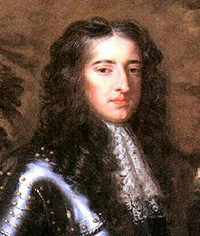 The history between Ireland and England is a troubled one, and in order to understand the meaning of the tricolour flag, we have to take a step backwards first. Back in 1688, King James II of England, a Catholic (and also King of Ireland and Scotland at the time), disrupted the expected heir lineage by having a son, James III. This, and the fact that the King was buddying up to France worried the opposing party, who did not want to see England become a Catholic state being directed by the Pope. The daughter of James II, Mary, was a Protestant, and married to William of Orange, who was a kind of de facto leader of the lower Dutch states. The Protestant leaders in Parliament had previously cooked up a anti-Catholic Exclusion Bill, designed to freeze out any future Catholic monarchs. A lot of this bad blood had to do with very real religious persecutions that had occured in England’s past, Guy Fawkes being just one of many past plots.
The history between Ireland and England is a troubled one, and in order to understand the meaning of the tricolour flag, we have to take a step backwards first. Back in 1688, King James II of England, a Catholic (and also King of Ireland and Scotland at the time), disrupted the expected heir lineage by having a son, James III. This, and the fact that the King was buddying up to France worried the opposing party, who did not want to see England become a Catholic state being directed by the Pope. The daughter of James II, Mary, was a Protestant, and married to William of Orange, who was a kind of de facto leader of the lower Dutch states. The Protestant leaders in Parliament had previously cooked up a anti-Catholic Exclusion Bill, designed to freeze out any future Catholic monarchs. A lot of this bad blood had to do with very real religious persecutions that had occured in England’s past, Guy Fawkes being just one of many past plots.
William of Orange and Mary both feared a French-Anglo double team against remaining Protestant states and subjects. So in 1688, William’s forces invaded England and scared James II, putting him on the run to France. By 1689, William and Mary had convinced Parliament to make them co-monarchs in return for withdrawing their troops. This was pretty much the end of Catholicism in the English monarchy, as Parliament also put measures in place that would bar Catholics from taking the crown in the future.
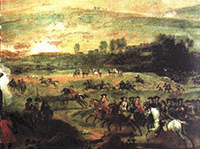 During this time, a vocal minority of Scottish and English clergy remained loyal to James II, claiming that the monarchy came from God, not Parliament. Ireland, largely Roman-Catholic was also behind James. This all came to a head at the Battle of the Boyne, fought in Ireland in 1690. For the Irish, this was more about gaining Irish autonomy and tolerance for Irish Catholicism. The Irish backed James as a means to settle their many grievances with the Protestant settlers in Ireland and English control of their land. William’s side won that battle, and subsequently gave some concessions to religious freedom in Ireland, but without restrictions as well. Irish-Catholics could remain land-owners, but had to swear allegiance to William and the English throne. Catholics in Ireland also had limits on the amount of land they could own, and could not own weapons or work in the legal trade.
During this time, a vocal minority of Scottish and English clergy remained loyal to James II, claiming that the monarchy came from God, not Parliament. Ireland, largely Roman-Catholic was also behind James. This all came to a head at the Battle of the Boyne, fought in Ireland in 1690. For the Irish, this was more about gaining Irish autonomy and tolerance for Irish Catholicism. The Irish backed James as a means to settle their many grievances with the Protestant settlers in Ireland and English control of their land. William’s side won that battle, and subsequently gave some concessions to religious freedom in Ireland, but without restrictions as well. Irish-Catholics could remain land-owners, but had to swear allegiance to William and the English throne. Catholics in Ireland also had limits on the amount of land they could own, and could not own weapons or work in the legal trade.
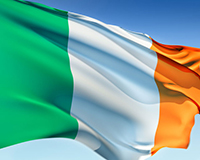 Ireland eventually won its sovereignty from England, and Northern Ireland remains part of the United Kingdom. Northern Ireland is mostly Protestant, and the Republic of Ireland largely Catholic. Northern Ireland had its own flag from 1953 to 1972, but today flies the Union Jack. The tricolour flag of Ireland first flew in 1848, during the Young Irelander Rebellion, again in 1919 during the Irish fight for independence, and became the official flag of the Republic of Ireland in 1937. Although the colors are “officially” not supposed to represent anything, such colors are not without meaning. The green represents the Irish Nationalists or Republicans, the orange represents the Protestants, or those who were loyal to William back in the late 1600s, and the white is supposed to represent peace and transparency between all the citizens of Ireland.
Ireland eventually won its sovereignty from England, and Northern Ireland remains part of the United Kingdom. Northern Ireland is mostly Protestant, and the Republic of Ireland largely Catholic. Northern Ireland had its own flag from 1953 to 1972, but today flies the Union Jack. The tricolour flag of Ireland first flew in 1848, during the Young Irelander Rebellion, again in 1919 during the Irish fight for independence, and became the official flag of the Republic of Ireland in 1937. Although the colors are “officially” not supposed to represent anything, such colors are not without meaning. The green represents the Irish Nationalists or Republicans, the orange represents the Protestants, or those who were loyal to William back in the late 1600s, and the white is supposed to represent peace and transparency between all the citizens of Ireland.



